How To Trade Inside Bar Pattern



Editorial Note: While we adhere to strict Editorial Integrity, this post may contain references to products from our partners. Here's an explanation for How We Make Money. None of the data and information on this webpage constitutes investment advice according to our Disclaimer.
The best inside bar pattern trading strategies involve waiting for a breakout from the high or low of the inside bar and entering trades in the direction of the breakout. Traders can use stop-loss orders to manage risk and protect against false signals.
The inside bar pattern is a popular price action pattern used by traders to identify potential breakouts in the market. This pattern forms when the high and low of a candlestick are contained within the high and low of the previous candlestick, creating a consolidation phase. Trading the inside bar pattern involves waiting for the price to break out of the high or low of the inside bar and entering a trade in the direction of the breakout. To manage risk, a stop-loss order is placed below the low or above the high of the inside bar. This article will provide insights and strategies on how to effectively trade the inside bar pattern and capitalize on breakout opportunities in the market.
Best inside bar trading strategies
Inside Bar Pattern refers to a chart pattern where a smaller candle, known as the inside bar, is engulfed within the range of a larger candle, often referred to as the mother bar. This pattern typically occurs after a significant market move and signifies a period of consolidation.
Understanding how to effectively trade the inside bar pattern can provide powerful insights into price action. It is important to note that while matching highs and lows are acceptable, the range of the inside bar should not exceed that of the mother candle by even a single point.
Range Trading: One approach to trading the inside bar pattern is in a ranging market. After a significant price move, the inside bar indicates a potential consolidation phase or market equilibrium. To confirm this setup, you can use the Relative Strength Index (RSI) as a confluence tool, observing the RSI around 40-50, indicating indecision and the likelihood of consolidation. Traders can enter trades targeting small price movements within the established range, focusing on support and resistance levels
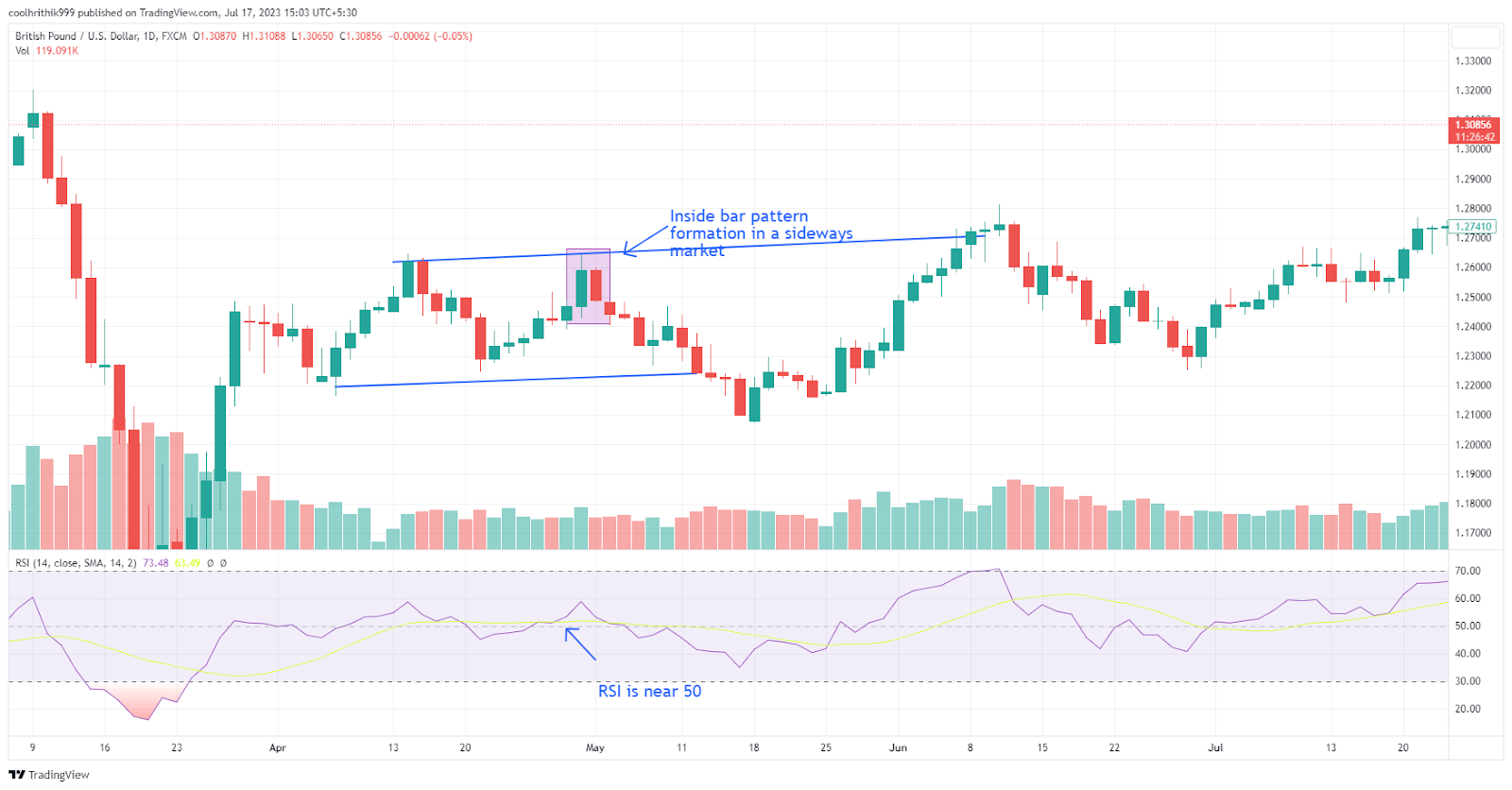 Inside bar pattern
Inside bar patternBreakout Trading: Another method is the inside bar breakout strategy, which offers more excitement. This involves identifying an inside bar formation with a large bearish candle followed by a smaller bullish candle within the first candle's range. The key signal occurs when the third candle rises above the second candle, indicating a potential price increase. Stop-loss orders can be placed at the lowest price level of the mother candle or the lowest level of the previous price swing, while take profit targets the highest level of the last swing price
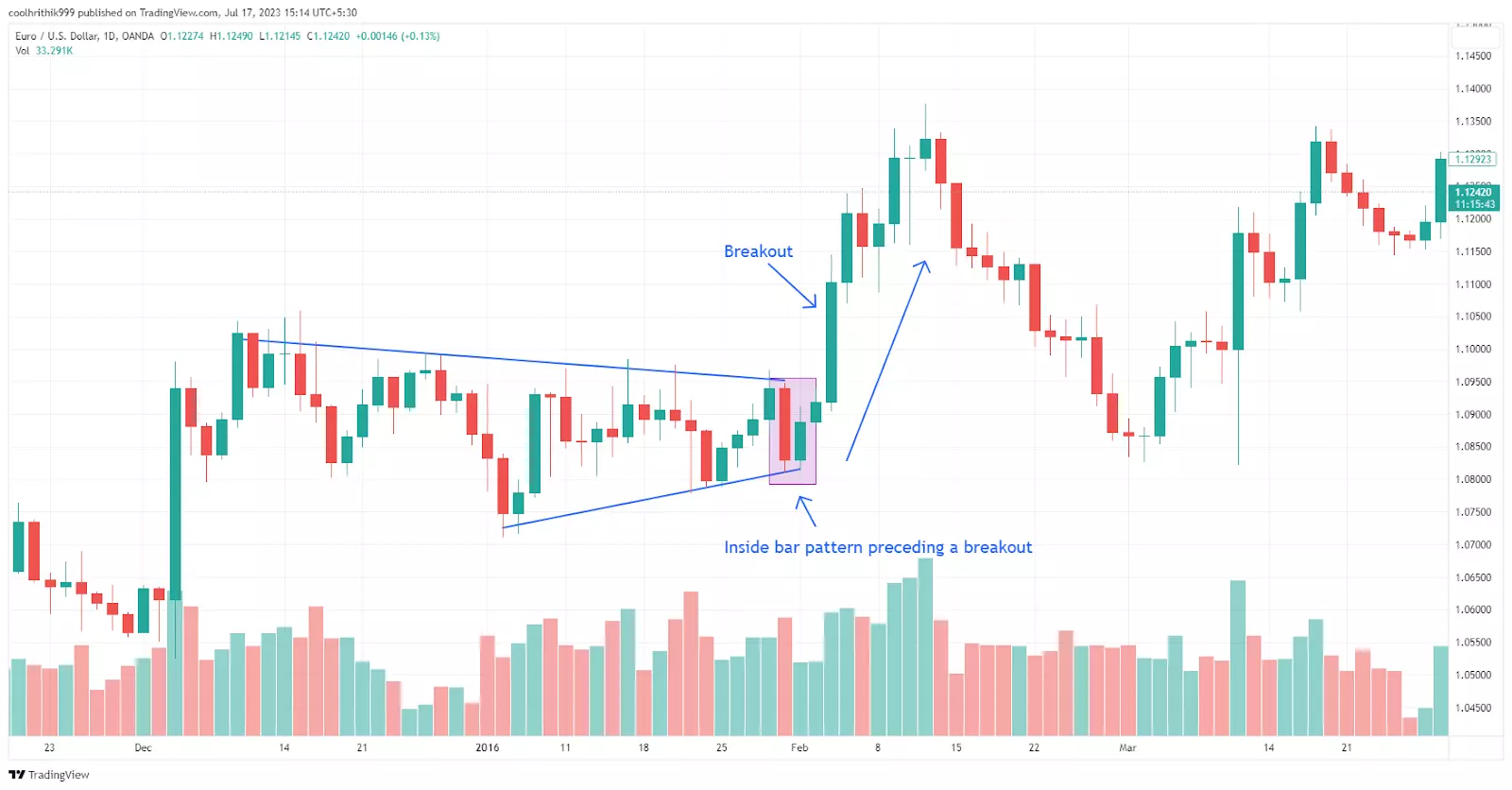 Inside bar pattern
Inside bar patternIdentify breakthrough potential as it develops
When an inside bar develops, it indicates a period of consolidation that could potentially lead to a breakout in the near future. However, to take advantage of this breakout potential, it is crucial to identify whether the breakout is likely to result in price appreciation or depreciation.
To evaluate this, consider the price's trend leading up to the inside bar formation. A profitable inside bar setup often exhibits a price movement that aligns with the trend prior to the inside bar. If the price is already trending upwards before the consolidation period, it is more probable that the breakout will continue in the same direction.
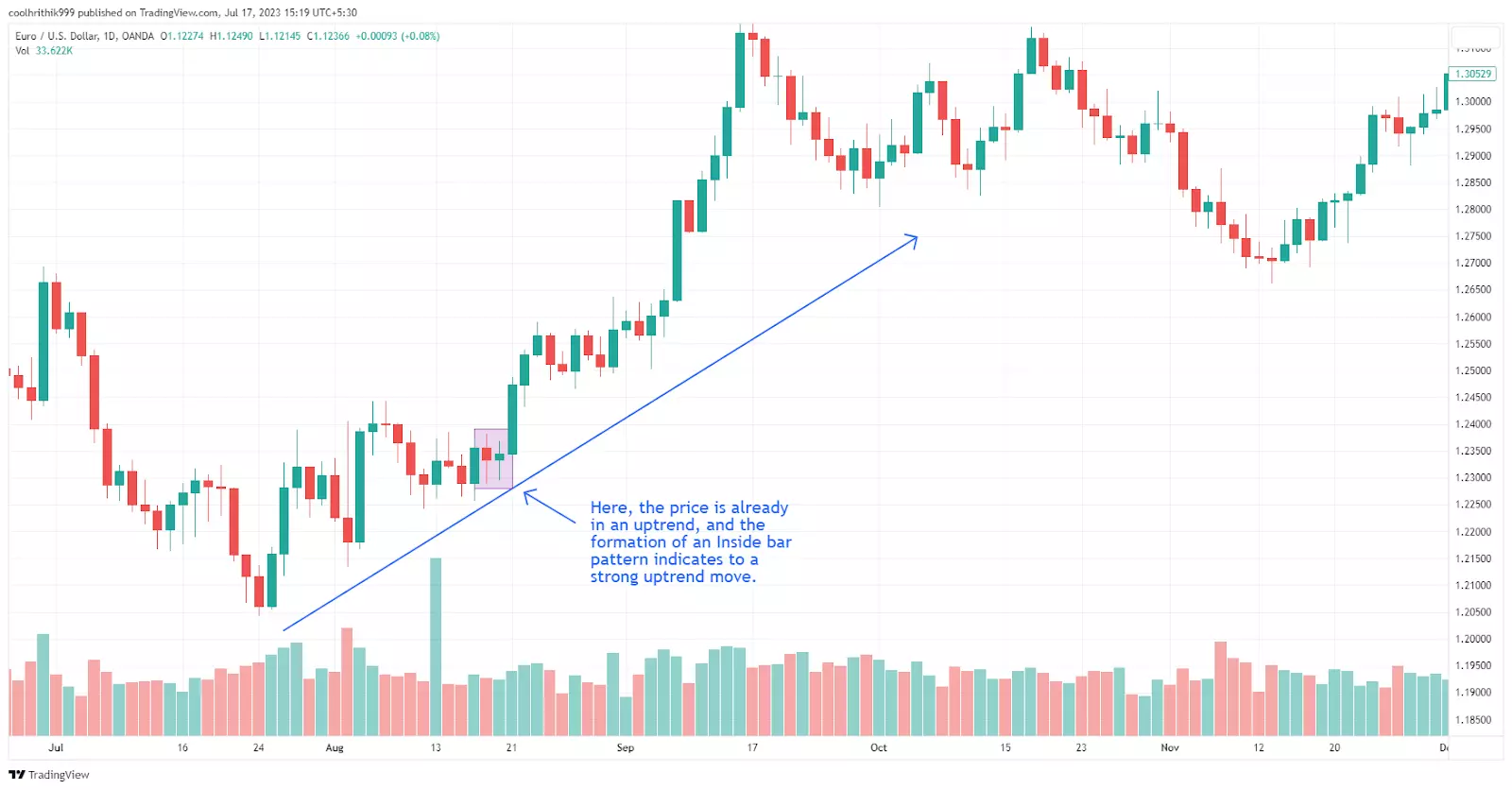 Inside bar pattern
Inside bar patternAdditionally, assessing the risk/reward potential of a trade is essential. Ideally, the risk should be lower than half of the potential reward. Therefore, an inside bar setup is favorable when its trend, relationship to existing resistance levels, and other chart indicators indicate a strong breakout potential.
Features of trading inside bars under the daily chart
When it comes to trading inside bars, analyzing the daily charts proves to be the most valuable approach. Daily charts provide a larger sample size of price action, offering more reliable insights into market consolidation and potential breakouts.
On shorter time frames, such as one-hour or four-hour charts, inside bars are quite common and may not always indicate significant consolidation. To enhance the accuracy of your analysis, it is crucial to back up short-term inside bars with strong chart patterns or other technical indicators that suggest imminent price movement.
However, it is important to note that evaluating data from narrower time frames may yield weaker evidence compared to the robustness of daily charts. The validity of inside bar signals tends to be stronger when observed on the daily chart, which captures a broader picture of market dynamics.
To maximize the effectiveness of inside bar trading strategies, it is advisable to avoid time frames shorter than the daily chart. Lower time frames are more susceptible to market "noise", leading to false signals and potentially misleading trading decisions.
The significance of an inside bar formation on higher time frames, such as the daily chart, lies in the weight it carries. The longer formation period of the pattern implies greater participation from traders and higher capital flows. Consequently, the potential breakout or continuation signals provided by inside bars on the daily chart hold more credibility.
One commonly used technical indicator to validate the inside bar pattern is the Moving Average Convergence Divergence (MACD). The MACD helps assess the momentum and trend direction in the market. Traders can look for convergence or divergence between the MACD line and signal line around the inside bar formation. Convergence indicates potential price continuation, while divergence may suggest a reversal or consolidation phase. By combining the inside bar pattern with the MACD indicator, traders can increase their confidence in identifying successful trade opportunities.
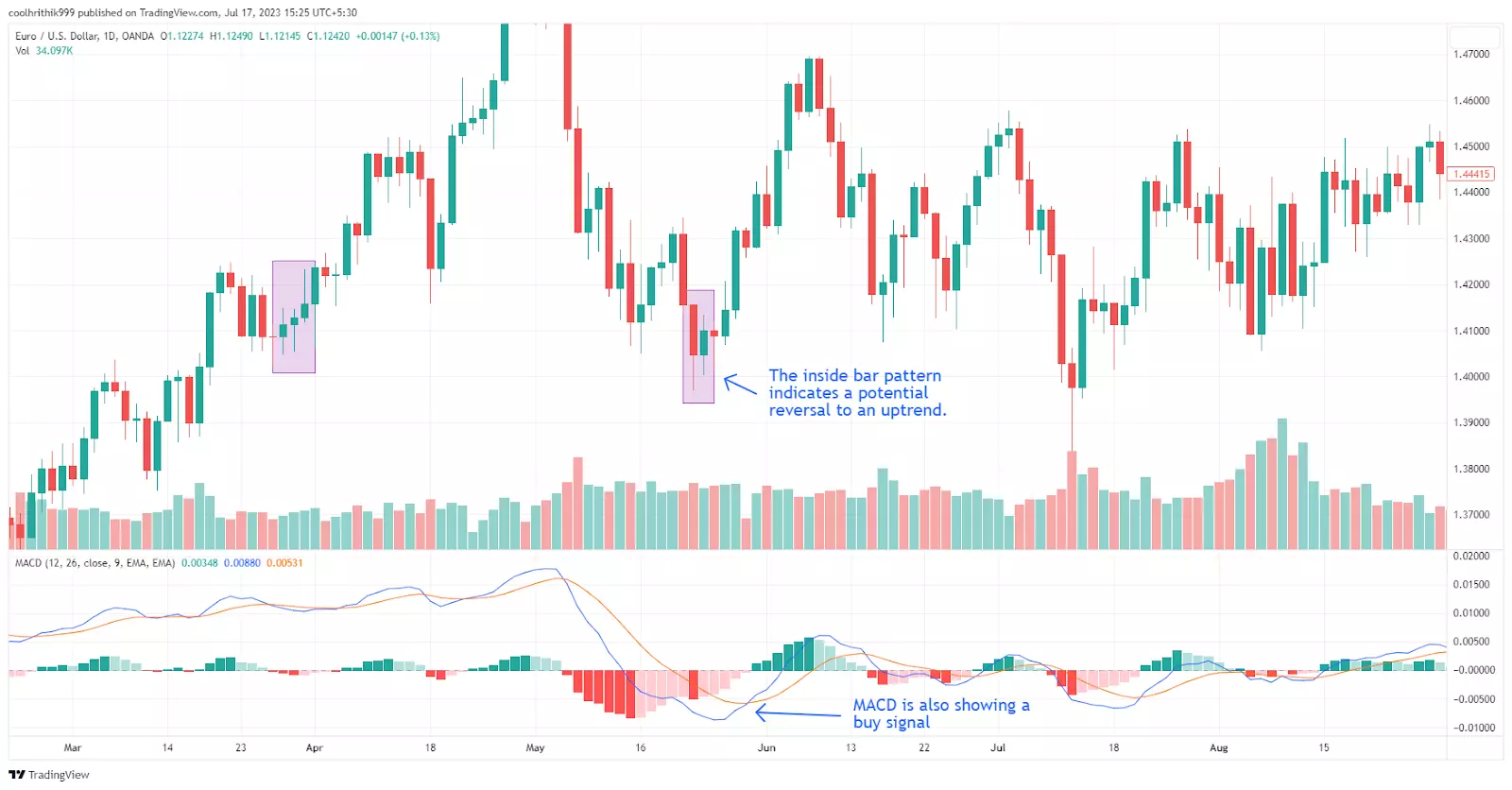 Inside bar pattern
Inside bar patternTrack consolidation from one day to the next
Inside bars on daily charts allow traders to track consolidation from one day to the next. This helps determine the direction in which prices may break out. By referring to the trend of the daily bar, traders can gain insights into the underlying market sentiment.
For example, consider a bullish trend where the price has been consistently making higher highs and higher lows. If an inside bar forms within this uptrend, it suggests a temporary consolidation before the uptrend potentially continues. Conversely, in a bearish trend, an inside bar may indicate a brief pause before the downtrend resumes.
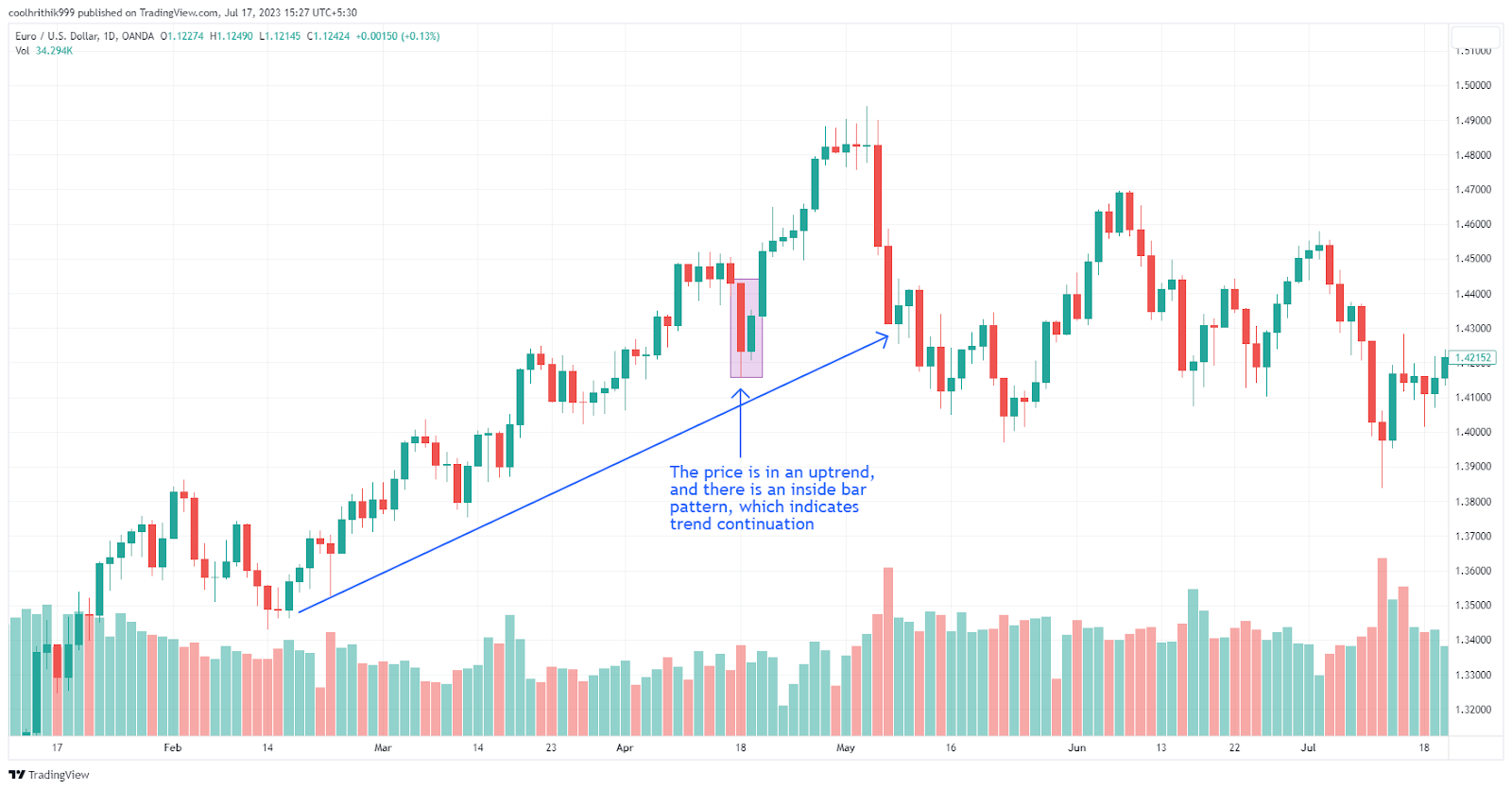 Inside bar pattern
Inside bar patternIt's important to remember that consolidation can take several days on daily charts before a breakout occurs. While an inside bar pattern may indicate upcoming price volatility, it does not guarantee a precise timeline for that movement.
When evaluating inside bars, pay close attention to the size of the bar relative to the preceding mother bar. A smaller inside bar in comparison to the previous bar indicates stronger consolidation signals, suggesting an imminent breakout. Conversely, when the size difference is minimal, the strength of the consolidation signal decreases. Therefore, consider the proportions of the inside bar setup as you assess the trade potential from one day to the next.
Use a stop-loss order
Implementing a stop-loss order is a crucial aspect of successful inside bar pattern trading strategies. It serves as a risk management tool to protect traders from potential losses and minimize the impact of false positive signals.
Inside bars, while reliable patterns, are not foolproof. There is always a possibility of false signals or unexpected market movements that can lead to unfavorable outcomes. By using a stop-loss order, traders can set a predetermined level at which they are willing to exit the trade if the market moves against their anticipated direction.
The purpose of a stop-loss order is to limit potential losses and provide traders with an exit strategy in case the inside bar pattern does not result in the expected breakout or continues to consolidate without a clear direction. It helps to control risk and protect capital, ensuring that losses are kept within acceptable limits.
Trading inside bars: Pros and cons
Trading inside bar patterns comes with its own set of advantages and disadvantages. Understanding these pros and cons can help traders make informed decisions when incorporating inside bar patterns into their trading strategies.
- Pros
- Cons
- Frequent occurrence: Inside bar patterns are commonly found in the markets, presenting traders with numerous opportunities to identify and capitalize on potential trading setups
- Easy identification: Inside bars are relatively easy to identify on price charts. Their distinct structure, where the range of the current bar is contained within the previous bar, makes them recognizable patterns
- Reversal and continuation signals: Inside bars can act as both reversal and continuation signals, depending on their location within the price chart and the prevailing trend. This versatility provides traders with flexibility in adapting their trading strategies to different market conditions
- Abundance of trading opportunities: The profitability of inside bar setups allows traders to find multiple trading opportunities, particularly for those employing intraday trading techniques. This pattern's ability to generate frequent setups can lead to consistent trading activity
- Ambiguous market direction: While inside bar patterns indicate consolidation in the market, they do not provide clear guidance on the future direction of prices. Traders may face challenges in determining whether the market will break out or continue consolidating
- Supplementary tools required: To enhance the reliability of inside bar signals, traders often need to combine this pattern with other technical analysis tools. Relying solely on inside bar patterns may not provide sufficient information for making trading decisions
Tips on trading the inside bar pattern
Practice identifying inside bars on your charts before trading them live: Familiarize yourself with the visual characteristics and formation of inside bars through historical chart analysis to enhance your recognition skills
Focus on the daily time frame for optimal inside bar trading: The daily chart provides a broader perspective of price action, allowing you to capture the significance and potential breakout opportunities of inside bars
Confirm inside bar patterns with other technical indicators or chart patterns: Combine the inside bar signal with additional tools like trendlines, moving averages, or support and resistance levels to strengthen your trading decision
Consider the trend direction before trading an inside bar setup: Assess the prevailing market trend to align your inside bar trades with the overall direction, increasing the probability of successful trades
Set appropriate stop-loss orders to manage risk: Determine a strategic placement for your stop-loss order below the inside bar's low (for long trades) or above the inside bar's high (for short trades) to limit potential losses in case of adverse price movements
Best Forex brokers 2025


Summary
Trading the Inside Bar Pattern offers traders a valuable strategy for identifying potential breakouts and trend reversals. Inside bars, which occur when a smaller candle is engulfed within a larger one, indicate consolidation in the market. By analyzing inside bars on daily charts, traders can gain a larger sample size of price action and increase the validity of their trading signals. It is crucial to consider the size of the inside bar relative to the mother bar, the trend direction, and the use of additional technical indicators to confirm trades.
Implementing stop-loss orders helps manage risk effectively. While inside bars provide numerous trading opportunities, it is essential to practice identifying them and utilize other tools for more accurate analysis. By mastering the Inside Bar Pattern, traders can enhance their trading strategies and potentially capitalize on profitable market moves.
FAQs
How do you trade inside a bar pattern?
To trade inside an inside bar pattern, you can wait for a breakout in either direction and enter a trade in the direction of the breakout.
What is the win rate for inside bar strategy?
The success rate of the inside bar strategy can differ based on market conditions and the trader's skill level. It is advisable to conduct backtesting and analyze past data to assess the win rate associated with a particular trading configuration.
How powerful is the inside bar candle?
The power of an inside bar candle depends on various factors, such as its position within the trend, its size relative to the mother candle, and the confirmation from other technical indicators. It can be a strong signal for potential breakouts or trend reversals.
How do you trade double inside a bar?
Trading a double inside bar involves identifying two inside bars consecutively within the same price range. Traders can wait for a breakout in either direction and enter a trade accordingly, considering the prevailing trend and other technical factors.
Related Articles
Team that worked on the article
Chinmay Soni is a financial analyst with more than 5 years of experience in working with stocks, Forex, derivatives, and other assets. As a founder of a boutique research firm and an active researcher, he covers various industries and fields, providing insights backed by statistical data. He is also an educator in the field of finance and technology.
As an author for Traders Union, he contributes his deep analytical insights on various topics, taking into account various aspects.

Dr. BJ Johnson is a PhD in English Language and an editor with over 15 years of experience. He earned his degree in English Language in the U.S and the UK. In 2020, Dr. Johnson joined the Traders Union team. Since then, he has created over 100 exclusive articles and edited over 300 articles of other authors.
Mirjan Hipolito is a journalist and news editor at Traders Union. She is an expert crypto writer with five years of experience in the financial markets. Her specialties are daily market news, price predictions, and Initial Coin Offerings (ICO).
Yield refers to the earnings or income derived from an investment. It mirrors the returns generated by owning assets such as stocks, bonds, or other financial instruments.
Price action trading is a trading strategy that relies primarily on the analysis of historical price movements and patterns in financial markets, such as stocks, currencies, or commodities. Traders who use this approach focus on studying price charts, candlestick patterns, support and resistance levels, and other price-related data to make trading decisions.
Options trading is a financial derivative strategy that involves the buying and selling of options contracts, which give traders the right (but not the obligation) to buy or sell an underlying asset at a specified price, known as the strike price, before or on a predetermined expiration date. There are two main types of options: call options, which allow the holder to buy the underlying asset, and put options, which allow the holder to sell the underlying asset.
The informal term "Forex Gods" refers to highly successful and renowned forex traders such as George Soros, Bruce Kovner, and Paul Tudor Jones, who have demonstrated exceptional skills and profitability in the forex markets.
Risk management is a risk management model that involves controlling potential losses while maximizing profits. The main risk management tools are stop loss, take profit, calculation of position volume taking into account leverage and pip value.




























































































































